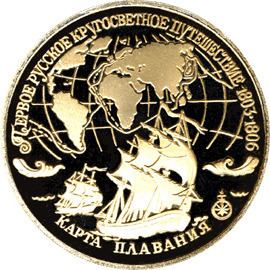 | ||
The first Russian circumnavigation of the Earth took place from August 1803 to August 1806. It was sponsored by Count Nikolay Rumyantsev, funded by the Russian-American Company, and was headed by Adam Johann von Krusenstern. In addition to its exploratory goals, the expedition was also meant to help establish diplomatic and economic relations between Russia and Japan, for which the party included a large diplomatic delegation headed by Court Chamberlain and Ambassador Nikolai Rezanov.
Contents
Events
After publishing a paper pointing out the advantages of direct communication between Russia and China by Cape Horn or the Cape of Good Hope, Krusenstern was appointed by Tsar Alexander I to make a voyage to the east coast of Asia to endeavour to carry out the project. Under the patronage of the Tsar, Krusenstern and Rezanov co-led the first Russian circumnavigation of the world. The purpose of the two-ship expedition was to establish trade with China and Japan, introduce Rezanov as first Russian ambassador to Japan, facilitate trade in South America, and examine California for a possible colony.
Two ships, Nadezhda ("Hope", formerly Leander) under the command of Krusenstern, and Neva (formerly Thames) under the command of Captain-Lieutenant Yuri F. Lisianski took part in the voyage. Starting from Kronstadt, both ships took a route across the Baltic Sea and the Atlantic Ocean, past the Canary Islands and Brazil, after which the ships rounded Cape Horn and set across the Pacific Ocean towards Japan, making stops at the Marquesas and the Sandwich (Hawaiian) Islands, and also at Kamchatka. However, after leaving Hawaii the ships split, and Lisianski headed to Russian America (Alaska).
The visit to Japan was a diplomatic failure, even if as a gesture of good will the Russians brought with them valuable gifts and several Japanese castaways rescued years before in the Russian North Pacific territories (these sailors thus became the first Japanese to circumnavigate the world). Nikolai Rezanov had to cancel his embassy as Japan reaffirmed once more the isolationist sakoku ("closed country") policy.
After visiting Japan, Nadezhda set off towards Sitka, Alaska, sailed past China and Macao on the Indian Ocean, then rounded Africa and came back across the Baltic Sea to Kronstadt. The voyage lasted a total of more than three years, from 7 August 1803 to 19 August 19 1806.
In 1804 Neva visited Easter Island, and later that year, was essential in defeating the Tlingit in the Battle of Sitka, Alaska. In 1805 Lisianski met Krusenstern again in Macau, but they soon separated. Also in 1805, he was the first to describe the Hawaiian monk seal on the island which now bears his name. Neva returned to Kronstadt on 22 July 1806, almost a month before Nadezhda. Lisyanski received multiple rewards for his circumnavigate, including the Order of Saint Vladimir of 3rd degree. Both seafarers made maps and detailed recordings of their voyages.
Upon his return, Krusenstern wrote a detailed report, Reise um die Welt in den Jahren 1803, 1804, 1805 und 1806 auf Befehl Seiner Kaiserliche Majestät Alexanders des Ersten auf den Schiffen Nadeschda und Newa (Journey around the World in the Years 1803, 1804, 1805, and 1806 at the Command of his Imperial Majesty Alexander I in the Ships Nadezhda and Neva) published in Saint Petersburg in 1810. It was published in 1811-1812 in Berlin; this was followed by an English translation, published in London in 1813, and subsequently by French, Dutch, Danish, Swedish, and Italian.
